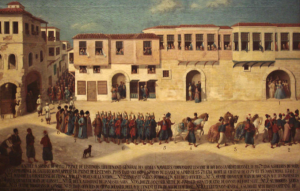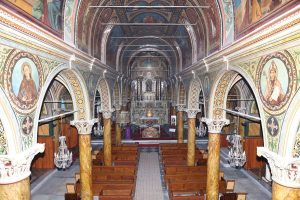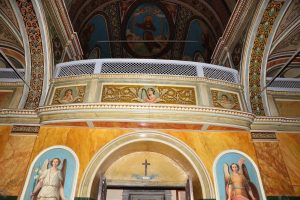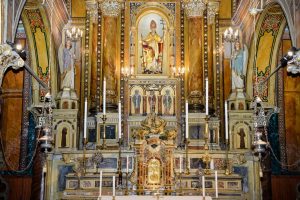Church History
The Church of St. Polycarp is situated in the Alsancak neighborhood of the Turkish city of Izmir. Polycarp, the Bishop of Smyrna, who lived from 69 to 155 AD, was honored by its dedication.
History and Architecture of St. Polycarp Church
 On the western wall of the church narthex, there is a lengthy inscription that was painted there about 1820. The church’s construction is attested to by this inscription. King XIII is mentioned in this inscription: “Louis’ renowned kingship, kind nature, and distinguished memory have allowed for the documentation of this building. Year XIII of 1820. It was created in Izmir during the reign of King Louis of France by Kapusen Priest Policarp and General Consul Priest Piere David. Jean Dupis of Marseille, the French Vice-Consul, founded it. On December 23, 1630, the Roman Saint Religious Organization began construction on it as a district church.”
On the western wall of the church narthex, there is a lengthy inscription that was painted there about 1820. The church’s construction is attested to by this inscription. King XIII is mentioned in this inscription: “Louis’ renowned kingship, kind nature, and distinguished memory have allowed for the documentation of this building. Year XIII of 1820. It was created in Izmir during the reign of King Louis of France by Kapusen Priest Policarp and General Consul Priest Piere David. Jean Dupis of Marseille, the French Vice-Consul, founded it. On December 23, 1630, the Roman Saint Religious Organization began construction on it as a district church.”
The church was restored in 1744, according to an inscription on the building’s north wall. On the wall murals within the building, one can read the names and dates of the painters. R.C. Pere during 1894 and 1895 It is possible to read the name of the painter, Pere.
The earthquakes and fires in Zmir destroyed records pertaining to churches. One of the well-known archives on church history is L. Misir’s work, which is based on records in the French archives.
Prince of Listenois Joseph de Bauffremont (1714–1781) in front of the old French Consulate in Smyrna, 1766. The church was severely damaged but still stood after the 1922 fire that destroyed the consulate, which was then relocated to its current site.
The church was built thanks to a vineyard donation from Jean Dupuis of Marseille. On these grounds, the current church was primarily constructed as a chapel between 1628 and 1630. From December 23, 1630 through 1885, it served as the community’s church (Paroisse).
The church, which was devastated by fire in 1773 and rebuilt in 1775 as a basilica for three generations with the help of Louis XVI, had previously been destroyed by an earthquake in 1688. According to the accounts, during this building, a cemetery and a monastery were erected close to the church. The tombstones with inscriptions in Italian, Latin, Armenian, and Arabic that were used to cover the floor of the current church were most likely taken from the cemetery in 1863.
The church was renovated and expanded with chapels by Capuchin Priest T. R. Pere Bernardin de Monte Marciano between 1892 and 1898.
C.R. We can see that wall paintings created by Pere and A. Scarselli in 1894–1895. Bishop Monsignor A.P. The church was dedicated by Timonia and made available for service on January 16, 1898.
Architectural Structure of St. Polycarp Church
A three-aisled basilica makes up the structure. Its measurements are 33.60 x 16.50 meters from east to west. There is a power nave in the basilica that is divided by five columns. The bema maintains the same arrangement of columns and arches dividing the naves. What is broader than the center nave. There are niches that are furnished opposite one another on the north and south walls of the naos.
Two approaches go to the bema area on the east side of the structure, while a north entrance leads to the prothesis space. Three window apertures, one on the west and two on the east, may be seen on the south wall of the naos, directly close to the narthex. On the north wall, much as the south wall, there are two windows that open to the outside. The entrance to the prosthesis is situated in the eastern portion of the north wall.
To the west of the structure is a narthex part. The steps on the southwest corner lead up to the organ tribune, which is located above the narthex. From the curvy side in the north, one enters the rectangular narthex area. Three different entrances that lead to the center nave and side naves allow access to the chaotic zone from the narthex. A door facing the turmoil in the north is located in the third apartment from the west, apart from this. One travels to the prothesis and then the church from the homes to the east of the edifice.
The structure was integrated with the homes while being created in a church’s garden. The cemetery, which was a 1775 addition to the building’s garden, no longer exists.
 Normally, the main entrance is situated on the axis of the apse, but in this instance, it is on the north side. Thin moldings surround the whole building on the eaves line of this façade, which runs east-west. These transverse components on the façades are balanced by vertical recessed piers that are separated into panels. The building’s repair in 1744 is documented in another inscription that may be found on these panels beneath the entrance and window.
Normally, the main entrance is situated on the axis of the apse, but in this instance, it is on the north side. Thin moldings surround the whole building on the eaves line of this façade, which runs east-west. These transverse components on the façades are balanced by vertical recessed piers that are separated into panels. The building’s repair in 1744 is documented in another inscription that may be found on these panels beneath the entrance and window.
Two entrances, one in the west corner and the other in the east, are located on the same façade. The entrance to the narthex is provided by this aperture. From the top, delicate moldings embellish the entrance’s circular arch. On its arch, there is a triple window opening. With a triangular pediment, the entrance’s top portion comes to an end.
East of the north façade, in the third unit of the naos, is a side entrance with a circular arch and plastic ornamentation. Similar to the narthex entrance, a triangular pediment tops it off.
Round moldings and arches surround the lone window on the north façade that faces the naos. In the lower portion of the window, there is another inscription. To the east of the entrance, there is another, more straightforward text that is inscribed into the wall.
The central nave façade, which is preserved taller than the side aisles of the naos, and three round-arched windows on the lower and upper levels are evident here on the south façade of the structure facing the road. The building’s facade does not carry on in a straight line. There are protrusions and recesses in several locations, which may be connected to the later-added walls.
In addition to the church, there are houses next to the structure in the east. The side rooms and eastern apse in particular in this portion are connected to the building complex from the outside.
St. Polycarp Church Interior Architecture
The main door is located on the west side of the north façade, and it is accessed from the narthex. The building’s inside is quite dark and has a mysterious design. The few windows and subsequent sealing of the three south-facing apertures lessen the amount of light that enters the room.

Altar and Bema
The bema area, whose floor is as high as two steps, is located to the east of the naos. On the bema, a horse may be seen below a gorgeous cut dome. Two enormous columns with lovely composite capitals form the apse niche and the east wall.
In addition to these, religious images used to produce sculptures and reliefs let you feel a member of the church’s eastern region and overall. The rows of columns and arches that divide the naves keep on. There are columns in the north and south as a result. The dome’s twelve slices, which span the centre of the three-unit bema, each feature an apostle. Four biblical writers are pictured on the pendants. On the north and south sides of the dome skirt, there are windows with circular arches.
On the side apses on either side of the bema, marble altar tables are placed on a two-stepped pedestal. The prothesis, which is accessed by the entrance on the bema’s northern wall, is illuminated by the window. The building’s northwest corner contains a stairway with a flat ceiling that leads to the dwellings. The church is said to have been constructed using brick and stone.
The façade of the church is split in half to the west by a molding with a transverse pipe at the first floor level. The coat of arms of the House of Bourbon is shown on the bottom portion of this façade.
The St. Polycarp Church is completely covered with oil paintings. On each of the dome’s twelve slices, which encompass the Bema region, there are medallion-enclosed pictures of the apostles. Gold gilding frames the medallions’ circle and the S-shaped relief’s relief in the center of the vegetal-patterned dome. The pendentive transitions’ triangular surfaces include images of the four evangelists, while the dome drum’s northern and southern side faces feature images of the bishops.
On the arches dividing the dome and the naos dust, there are circular polygonal panels with pictures of church leaders. Each ornament on the belly portions of the naos’ arches dividing the naves is adorned uniquely, with geometric interlacing and vegetable motifs making up the majority of the decorations. On the corners of these arches facing the nave are medallions with images of clergy, saints, and saints. Gilded vegetal motifs cover other open places.
St. Martyr mural inside the Polycarp church. As may be recognized by his autograph in the lower left corner of the artwork, local architect Raymond Péré created this mural representing St. Polycarp’s martyrdom. It’s thought that the mustachioed figure on the left is a self-portrait of this architect.
 Biblical images are depicted in various geometric panels on the top and side surfaces of the vault that covers the naos. Among these, rectangular frames with bishops shown from the front and length and thematic compositions with biblical events like the Annunciation and Birth may be observed. Additionally, St. Polycarp and the Murder of the Virgin of Thetokos scenarios can be chosen.
Biblical images are depicted in various geometric panels on the top and side surfaces of the vault that covers the naos. Among these, rectangular frames with bishops shown from the front and length and thematic compositions with biblical events like the Annunciation and Birth may be observed. Additionally, St. Polycarp and the Murder of the Virgin of Thetokos scenarios can be chosen.
Translate: Andrew Simes
